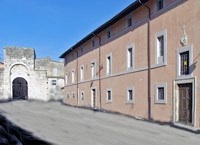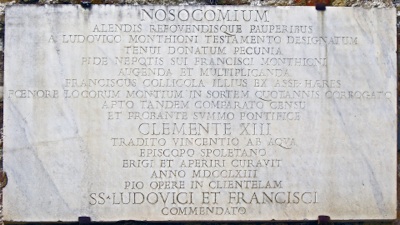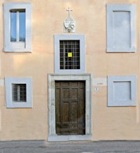


This was the site of the church (13th century) of Santa Croce and an adjacent hospice that was used by pilgrims on the road to Rome. In 1556, Bishop Alessandro Farnese put this hospice under the care of nuns from Sant' Angelo and SS Trinità.
The authorities became concerned about the lack of charitable institutions in Spoleto in the early 17th century: apart from the hospice at Santa Croce, the only substantial charitable undertaking in the city was at Santa Maria della Stella, and this had become restricted to the care of orphans. The authorities attempted to separate this orphanage from the nunnery in 1639, but they were unable to satisfy the nuns on the arrangements for the division of the associated income and property.
The impetus for reform was raised in 1704 when Lodovico Montioni, a nobleman from Spoleto, left a large legacy for the purpose. Bishop Marcello Durazzo left another substantial legacy for the same purpose in 1708. Francesco Montioni, a nephew of Lodovico, acted as executor for the fund, which he invested in Rome. He left yet another substantial legacy to it when he died in 1714.
In 1715 Bishop Carlo Giacinto Lascaris established the Congregazione dell’ Ospedale to administer the project. The nuns of Sant’ Angelo and SS Trinità were relieved of their obligations in relation to the hospice at Santa Croce in 1716, and the site was earmarked for a new hospital. The project was not immediately successful, and Francesco Collicola, the executor of the Montioni fortune, bought the alternative site of the ex-nunnery of Santa Caterina in 1718.
Monsignor Martino Innico Caracciolo
In 1726 the nuns of Santa Maria della Stella transferred the remaining orphans in their care to Santo Spirito, Rome. Some of the orphans died during this journey, and the resulting scandal prompted Pope Clement XII into action. He sent Monsignor Martino Innico Caracciolo to Spoleto in 1738 to reform the charitable institutions of the city. He formally removed any obligation to care for the orphans from the nuns of Santa Maria della Stella, in return for an annual payment, and transferred their residual charitable obligations to the new hospital, which was moved to the present site in 1747.

In 1762, Francesco Collicola faced litigation on the part of the Fabbrica di San Pietro, Rome in relation to the Montioni legacies. He appealed successfully to Pope Clement XIII, and the funds were duly transferred to Bishop Vincenzo Acqua in 1763. An inscription recording this success is now on the wall of San Matteo (see below).

In 1801, the hospital was absorbed by the military hospital at San Matteo to form the Ospedale di SS Carlo e Matteo, and the buildings on the original site were sold for residential use. The complex was re-modeled in 1996-2000 and now houses the Hotel San Carlo Borromeo.

